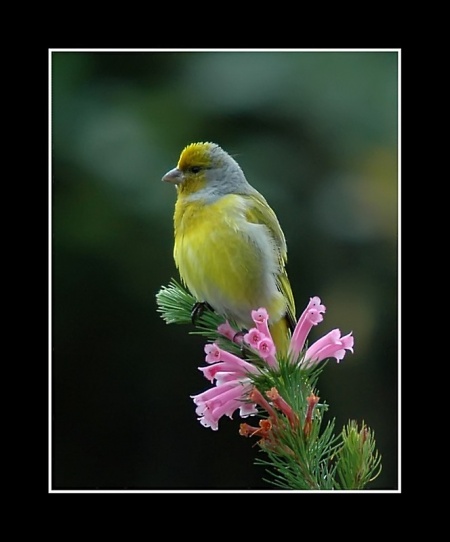m (split of Yellow-crowned Canary) |
(Imp sizes. Picture of juvenile. References updated) |
||
| Line 1: | Line 1: | ||
| − | [[Image:Cape_Canary.jpg|thumb| | + | [[Image:Cape_Canary.jpg|thumb|450px|right|Photo by {{user|Mybs|Mybs}}<br />[[Helderberg Nature Reserve]], south-western Cape, October 2004]] |
;[[:Category:Serinus|Serinus]] canicollis | ;[[:Category:Serinus|Serinus]] canicollis | ||
'''Includes Yellow-crowned Canary''' | '''Includes Yellow-crowned Canary''' | ||
==Identification== | ==Identification== | ||
| − | + | 11·5–14 cm (4½-5½ in)<br /> | |
'''Adult male''' | '''Adult male''' | ||
*Green back with black edged wing feathers wings and tail | *Green back with black edged wing feathers wings and tail | ||
| − | * | + | *Yellow underparts, rump and tail sides |
*White lower belly | *White lower belly | ||
*Rear head and neck are grey | *Rear head and neck are grey | ||
| Line 13: | Line 13: | ||
'''Juvenile''': greenish-yellow underparts with heavy brown streaking | '''Juvenile''': greenish-yellow underparts with heavy brown streaking | ||
====Similar Species==== | ====Similar Species==== | ||
| + | [[Image:Juv Cape Canary 2.jpg|thumb|350px|right|Juvenile<br />Photo by {{user|Doc+Duck|Doc Duck}}<br />Verloren Vallei, near Dullstroom, [[South Africa]], February 2017]] | ||
This species is easily distinguished from the [[Yellow-fronted Canary]] by its lack of black face markings. | This species is easily distinguished from the [[Yellow-fronted Canary]] by its lack of black face markings. | ||
==Distribution== | ==Distribution== | ||
South-eastern southern [[Africa]]. | South-eastern southern [[Africa]]. | ||
==Taxonomy== | ==Taxonomy== | ||
| − | Three subspecies are recognised: | + | Formerly considered [[Dictionary_A-C#C|conspecific]] with [[Yellow-crowned Canary]]. |
| − | *''S. c. canicollis''; south-western Cape to western Free State and southern KwaZulu-Natal | + | ====Subspecies==== |
| − | *''S. c. thompsonae''; [[Lesotho]], eastern Free State and northern KwaZulu-Natal to Limpopo Province | + | Three subspecies are recognised<sup>[[#References|[1]]]</sup>: |
| − | *''S. c. griseitergum''; eastern [[Zimbabwe]] and adjacent [[Mozambique]] highlands | + | *''S. c. canicollis''; south-western Cape to western Free State and southern [[KwaZulu-Natal]] |
| − | + | *''S. c. thompsonae''; [[Lesotho]], eastern Free State and northern KwaZulu-Natal to Limpopo Province | |
| − | + | *''S. c. griseitergum''; eastern [[Zimbabwe]] and adjacent [[Mozambique]] highlands | |
==Habitat== | ==Habitat== | ||
Scrub and grasslands with trees, copses, plantations, gardens, parks, road verges, croplands, orchards, fybos, montane grasslands. Most common in highland areas, but is found in coastal bush in [[South Africa]]. | Scrub and grasslands with trees, copses, plantations, gardens, parks, road verges, croplands, orchards, fybos, montane grasslands. Most common in highland areas, but is found in coastal bush in [[South Africa]]. | ||
| Line 32: | Line 33: | ||
It builds a compact cup nest, commonly in a shrub. | It builds a compact cup nest, commonly in a shrub. | ||
==References== | ==References== | ||
| − | # Fry H, Keith S,Woodcook M & Willis I. 2004. ''Birds of Africa Vol VII: Sparrows to Buntings''. Princeton University Press. ISBN 0713665319 | + | #{{Ref-Clements6thAug16}}#Fry H, Keith S,Woodcook M & Willis I. 2004. ''Birds of Africa Vol VII: Sparrows to Buntings''. Princeton University Press. ISBN 0713665319 |
| − | # | + | #{{Ref-Hockeyetal05}}#{{Ref-SinclairRyan03}}#AvianWeb |
| − | # | ||
| − | #AvianWeb | ||
{{ref}} | {{ref}} | ||
==External Links== | ==External Links== | ||
{{GSearch|Serinus+canicollis}} | {{GSearch|Serinus+canicollis}} | ||
[[Category:Birds]] [[Category:Serinus]] | [[Category:Birds]] [[Category:Serinus]] | ||
Revision as of 22:23, 4 March 2017
- Serinus canicollis
Includes Yellow-crowned Canary
Identification
11·5–14 cm (4½-5½ in)
Adult male
- Green back with black edged wing feathers wings and tail
- Yellow underparts, rump and tail sides
- White lower belly
- Rear head and neck are grey
- Cinnamon face
Female similar to male, but has less grey on the head.
Juvenile: greenish-yellow underparts with heavy brown streaking
Similar Species
This species is easily distinguished from the Yellow-fronted Canary by its lack of black face markings.
Distribution
South-eastern southern Africa.
Taxonomy
Formerly considered conspecific with Yellow-crowned Canary.
Subspecies
Three subspecies are recognised[1]:
- S. c. canicollis; south-western Cape to western Free State and southern KwaZulu-Natal
- S. c. thompsonae; Lesotho, eastern Free State and northern KwaZulu-Natal to Limpopo Province
- S. c. griseitergum; eastern Zimbabwe and adjacent Mozambique highlands
Habitat
Scrub and grasslands with trees, copses, plantations, gardens, parks, road verges, croplands, orchards, fybos, montane grasslands. Most common in highland areas, but is found in coastal bush in South Africa.
Behaviour
Occurs singly, in pairs, or in flocks of up to 500.
Diet
Forages for seeds on ground, and in scrub, weeds, and trees.
Breeding
It builds a compact cup nest, commonly in a shrub.
References
- Clements, J. F., T. S. Schulenberg, M. J. Iliff, D. Roberson, T. A. Fredericks, B. L. Sullivan, and C. L. Wood. 2016. The eBird/Clements checklist of birds of the world: v2016, with updates to August 2016. Downloaded from http://www.birds.cornell.edu/clementschecklist/download/
- Fry H, Keith S,Woodcook M & Willis I. 2004. Birds of Africa Vol VII: Sparrows to Buntings. Princeton University Press. ISBN 0713665319
- Hockey, PAR, WRJ Dean, and PG Ryan, eds. 2005. Roberts' Birds of Southern Africa. 7th ed. Cape Town: John Voelcker Bird Book Fund. ISBN 978-0620340533
- Sinclair, I and P Ryan. 2003. Birds of Africa South of the Sahara. Princeton: Princeton Univ. Press. ISBN 978-0691118154
- AvianWeb
Recommended Citation
- BirdForum Opus contributors. (2024) Cape Canary. In: BirdForum, the forum for wild birds and birding. Retrieved 24 April 2024 from https://www.birdforum.net/opus/Cape_Canary





